“Could Hamlet have been written by a committee, or the Mona Lisa painted by a club? Could the New Testament have been composed as a conference report? Creative ideas do not spring from groups. They spring from individuals. The divine spark leaps from the finger of God to the finger of Adam.”
– Alfred Whitney Griswold, American educator
What Griswold clearly didn’t know when he said that is that his examples were likely really poor ones. These days we question whether or not Hamlet or any other “Shakespearean” work was written by someone named Shakespeare or even all by the same person. The New Testament may not have been a conference report, but it certainly wasn’t the work of a single individual. And painting the Mona Lisa was of such little interest to Leonardo de Vinci that he got bored and went to work on other paintings and just dabbled at it on and off for nearly 16 years. This last weekend was the 100th anniversary of the infamous theft of one of the world’s most famous paintings – something it didn’t even become until a few short decades (in contrast to the four centuries that had passed since it was completed) before its theft. What better whimsical theme to inspire a Casa SaltShaker dinner?
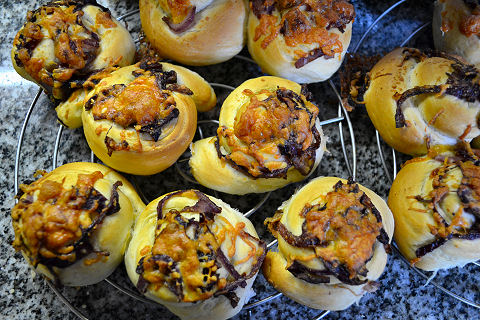
First off, our bread for the evening. We’ll get to the man and the story shortly, but for the moment, our thief was from the Lombardia region of Italy, and this is my favorite bread from the area, fitascetta. Normally made in a large coiled version, or a ring, it is a rich olive oil bread, fairly straightforward on its own, topped with caramelized red onions and often, grated cheese. I made it into individual dinner rolls – the cheese in this case a mix of grated mozzarella and cheddar.
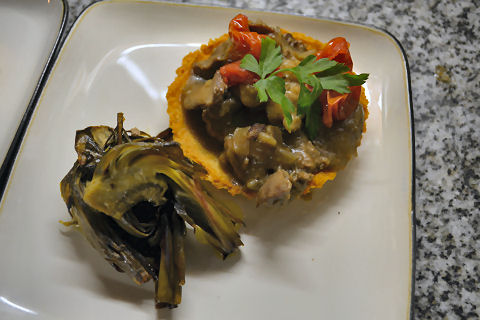
The story of the Mona Lisa, in a nutshell, is that Leonardo was commissioned by a Florentine silk merchant, Francesco del Giocondo, to paint a portrait of his wife, Lisa (Gherardini) del Giocondo, in 1503. He worked on it now and again over a four year period, meanwhile accepting other commissions, and then simply gave it up at some point. He moved to France, and again, picked up the work and dabbled at it for another three years, then put it away again. Sometime shortly before his death in 1519 he pulled it out again and finished it off, more or less (he claimed at one point that he’d never actually finished a single painting in his life). Known as La Gioconda, it was left among his effects and his assistant sold it to King Francois I who kept it at Fontainebleu, later it was given to Louis XIV who moved it to Versailles, and after the French Revolution it was given to the Louvre where it remained until stolen, other than a brief stint on display in Napoleon’s bedroom at Tuilieres.
One of my favorite Florentine dishes is called cibreo. It’s usually used as a pasta sauce, though sometimes to top bruschetta – it’s essentially a braise of chicken dark meat, giblets and livers flavored with rosemary, sage and saffron (the last optional) cooked in chicken stock and white wine, and finished off with roasted cherry tomatoes. I made it a thicker, stew-like version and served it over mashed potato tartlet crusts, and accompanied it with garlic-roasted artichoke wedges, another local favorite. I made extra too, and the next day it served me well in traditional form served over pasta.
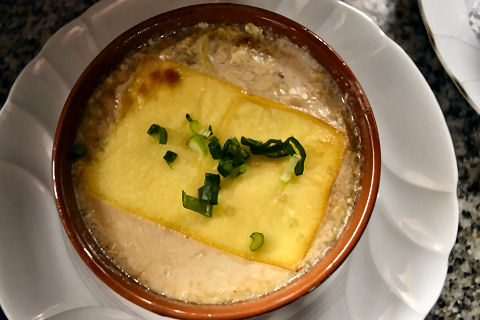
Our next character comes into the story in the early 1900s, the Marques Eduardo de Valfierno. Now, he’s a bit of a mystery figure, sort of like Leonardo DiCaprio in Catch Me if You Can, a con man, a jack of all trades. Little is really known about him, and much of what is is really just speculation. He was supposedly born in Rosario, Argentina, though as to whether it was to a local wealthy family or that he was the son of a servant is a murky tale. Years later he ended up in Paris, and, supposedly, was the mastermind behind the theft, though others say (if they admit he existed at all) that he merely got our thief thinking about it during a conversation. One of the fun things I did in prepping for this dinner was read through a fictionalized biography of him, Valfierno, by Argentine novelist Martín Caparrós, a completely engaging book.
Given the Rosario origin, I looked for traditional dishes, and the one that popped up was the Rosarino version of an Italian bagna cauda. In Italy, this is a warmed “fondue” of olive oil and butter intensely flavored with anchovies and garlic, into which bread and vegetables are dipped as an antipasto. The Rosarino version replaces the butter with cream, the anchovies and garlic are toned down a bit, and toasted walnuts are added to the mix. I turned it into a soup by making a mixed garlic and onion panade – a slow cooked soup I’ve made before with the onions and the addition of garlic cooked down to a near melted tangle, then mixed into a broth made of bread that’s been browned off in butter, and a mix of milk and vegetable stock. The whole thing pureed along with, in this case, anchovies and toasted walnuts. Into that a sauteed mix of the classic vegetables used to dip into it – celery, cauliflower, fennel, cabbage (I used Chinese cabbage), and cardoons, the last happening to be in season right now. Over the top, a slice of smoked provolone cheese, into the oven to broil and serve.
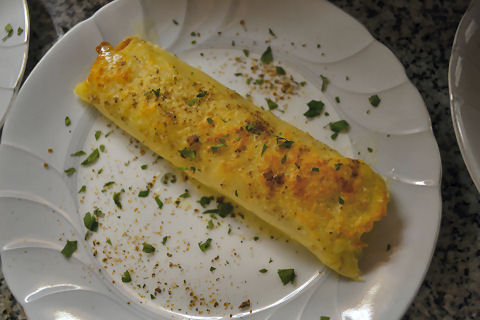
Next on our cast of characters, Yves Chaudron, a French artist who specialized in copying masterworks for resale to tourists, and, perhaps, at times for other purposes. For those who believe in the Valfierno involvement, Chaudron was contacted by him with the request that he produce six copies that could, again depending on the story, be sold at higher prices after the theft because the painting would be more famous, or to be used to throw the police off the trail of the real one. For those who don’t think Valfierno existed, Chaudron was a friend of our Lombardian thief, though the motives were once again the same.
Chaudron being from just north of Paris it was a moment to trot out a favorite from that area, one that was a wildly popular dish the last time I served it, ficelle picarde – slightly modified, it’s a simple crepe in which I layered both ham and smoked pork loin, a portobello duxelles, then rolled them up, placed them in a baking dish with some cream, grated some gruyere cheese over the top along with a dusting of nutmeg, and into to the oven to brown. They were pretty popular this time around too. The garnish is a dusting of shiitake powder and parsley.
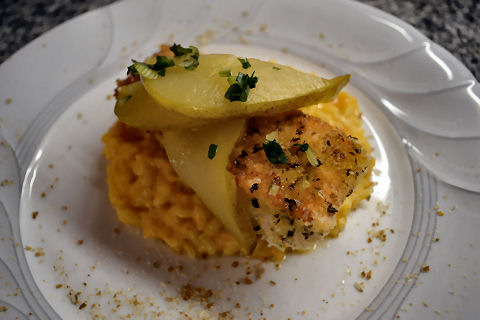
Finally, on to our thief, one Vincenzo Peruggia, an employee of the Louvre – likely that he got himself hired there on the maintenance crew with the theft already in mind. Again, the story becomes mixed – some say he was hired by Valfierno who intended to pay him a flat fee or a percentage of the resale of the Mona Lisa, others (and he, later) claim that he was motivated by patriotism, wanting to return the painting to Italy where he believed it belonged. On the night before the theft he entered the building with the rest of the crew, hid in a broom closet, and at some point removed the painting, placed it in his bag, and simply exited with the rest of the crew when his shift was over. The painting wasn’t even really missed immediately, the Louvre was closed for the day, and was in the process of photographing all of its works, so it was common for one or another to be absent from the walls. The following day a local artist who had wanted to study it and make some sketches asked about it, and the assumption on everyone’s part was that it was simply being photographed – had he left it at that it might have taken much longer to realize the theft, but he was agitated enough that someone went to check on when it would be returned to the walls – it still took until the next day before it was determined that it was not in the building. As to what happened at this point becomes, once again, unclear – Vincenzo maintained that he simply kept the painting for a couple of years until he was able to return to Italy, others say that he was waiting for Valfierno to pay him off. He never came under suspicion (though, along with the rest of the maintenance crew was questioned) as he continued to work at the Louvre as if nothing had happened, in fact, the prime suspect at one point was Pablo Picasso, who was actually arrested for the theft!
Lombardia is famous for its risottos, so I knew that would be the base – here, a vegetable stock risotto finished with roasted squash and mascarpone. Atop that a “salmon milanesa” – fresh salmon coated, in this case, in panko crumbs, parsley and oregano, browned and finished in the oven. And to garnish and add some acidity and kick to the dish, the classic Lombardian mostarda, or mustard fruits – in this case slices of pears that I’d “pickled” – the fruit is simmered until just softened in sugar syrup, then left to cool. Separately, vinegar and mustard powder (more traditionally, essential mustard oil, but I couldn’t find any here) are warmed until the mustard dissolves into it, and then the two are mixed and left for 1-2 days to infuse the fruit with the mustard flavor.
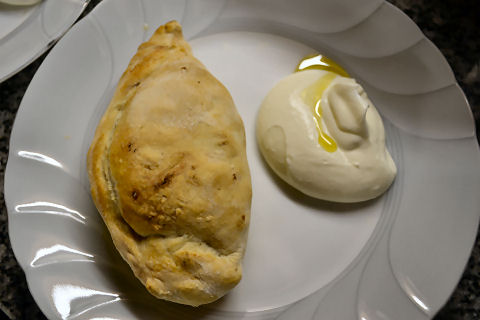
And finally, the last player in our drama, Alfredo Geri, the director at the time of the Uffizi Gallery, back in Florence. Two years after the theft, in 1913, he was contacted by Peruggia who claimed that he had the painting and had returned it to Italy to be repatriated. Geri set him up by arranging to meet him, where he was arrested and the painting was recovered. The Mona Lisa spent the next two years being displayed in various museums and galleries across Italy, and our thief was hailed as a hero of the nation, serving only six months in jail. He actually returned to France, to a small town called Annemasse in the southeast, where he married and opened a painting supplies shop, and lived until his death in 1925.
Having wound up back in Tuscany, I thought I’d finish off with a sweet calzone – the dough is a basic pizza dough that after being left to rise I mixed in lemon and orange peel, sugar, and sweet wine, then left it to develop flavor overnight. The filling is a mix of candied chestnuts, pecans, hazelnuts, chocolate, lemon and orange peel, and a splash of brandy. On the side, lightly sweetened whipped cream infused with rosemary and drizzled with lemon oil.
And that’s the story of our weekend’s Mona Lisa smiles all around!
Great theme, great story, and great menu! Thanks for an entertaining read.
[…] Salmon Milanesa, Pear Mostarda, Pumpkin Risotto […]
[…] traditional ficelle picardes for a couple of our French themed dinners way back, here, and here. This week’s version, given our selection of guests, had two restrictions on it – […]